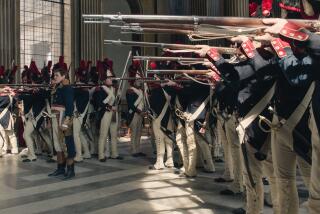Director Renoir’s lasting imprint
- Share via
THE second son of French Impressionist painter Pierre-August Renoir, filmmaker, author and actor Jean Renoir was one of the lions of 20th century cinema. For nearly 50 years, Renoir captivated and angered audiences with his bravura humanistic films with their themes of inequality among the classes, camaraderie, the futility of war, and the duality of human nature.
Among his triumphs were his 1937 antiwar film, “The Grand Illusion,” and his 1939 dark comedy about then-contemporary French society, “The Rules of the Game,” which was met with derision by the French when it was initially released. After an uneven stint in America in the 1940s, he made a series of Technicolor masterpieces, including 1951’s “The River” and 1954’s “French Cancan.”
Lionsgate has just released “Jean Renoir Collector’s Edition Box Set,” which includes four of his newly restored silents and two later projects that have had little exposure in the U.S.
Renoir made his directorial debut with the visually arresting 1925 romantic drama “La Fille de L’eau,” starring his first wife and his father’s last model, Catherine Hessling.
Hessling plays a waif named Virginie who lives with her father and lecherous uncle on a barge boat. After her father dies, her uncle drinks away his inheritance and sells the barge. Then he sets his sights on Virginie, but she fights off his attempt to rape her. But the fates have more cruelty in store for her after she escapes her uncle’s clutches. The film’s highlight is a surreal dream montage in which a delirious Virginie conjures up a bizarre fantasy version of her life.
The following year, Renoir brought Emile Zola’s novel “Nana” to the big screen. This lush, extravagantly produced drama, which flopped at the box office, stars Hessling as a theatrical diva without a shred of talent other than mesmerizing every man she meets.
The 1927 short “Sur un air de Charleston” was made by Renoir from material left over from “Nana” and was supposed to be the filmmaker’s tribute to jazz. Johnny Huggins plays a black-faced traveler from outer space who arrives on Earth only to discover that it’s in ruins because of a disaster. But he does find a semi-nude wild woman (Hessling) living in a shack who teaches him some clumsily erotic dances. It’s truly an oddity.
Hessling shows up one more time in the 1928 short, “La Petite marchande d’allumettes,” based on the fairy tale by Hans Christian Andersen. Despite then-cutting-edge special effects, the film is too dour to be enjoyable. Renoir and Hessling divorced in 1930.
“La Marseillaise,” from 1938, is considered Renoir’s one true epic. It’s a rousing, ambitious, all-star period drama that spans the early years of the French Revolution to the removal of the monarchy to the creation of the French nation. Renoir’s brother, Pierre, plays Louis XVI and Lise Delamare is Marie Antoinette.
Though not well received by critics in 1959, “Le Testament du Docteur Cordelier,” is an audacious update of Robert Louis Stevenson’s “Dr. Jekyll and Mr. Hyde.” Jean-Louis Barrault (“Children of Paradise”) gives a tour-de-force performance as the heartless doctor.
“Grand Illusion” was one of Renoir’s towering achievements -- a moving drama of friendship, class and morality set in a German POW camp during World War I. He returned to the same theme with his next-to-last film, 1962’s “Le Caporal epingle.” The comedy-drama revolves around a plucky French corporal (a disarming Jean-Pierre Cassel) who teams with two of his fellow captives to escape from a German POW camp during the early years of World War II.
Renoir had several ideas for films after “Caporal,” but he couldn’t get financing. His last project, 1970’s “Le Petit theatre de Jean Renoir,” was made for television. He died in Los Angeles in 1979.
More to Read
Only good movies
Get the Indie Focus newsletter, Mark Olsen's weekly guide to the world of cinema.
You may occasionally receive promotional content from the Los Angeles Times.











